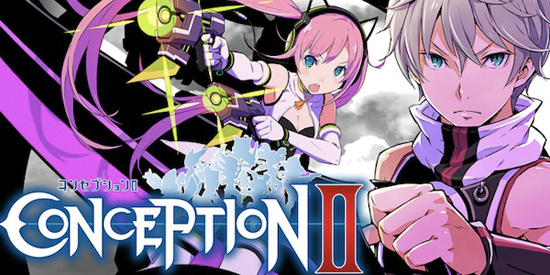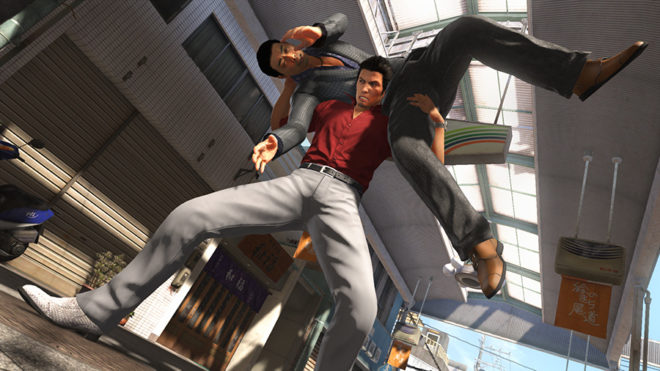Persona 5 — A Year of the Phantoms
 I didn’t envy Atlus’ Persona development team (known officially as “P-Studio”) during Persona 5’s development, as a significant burden was stacked on their shoulders. The Persona series became the company’s largest franchise by a huge margin starting with Persona 3, and Persona 4 only further secured that position as it became Atlus’ best-selling and most critically-approved game worldwide. So, the onus was on this team to make a sequel that either equaled or topped its predecessors in sales and reception. Given how long it spent in development (Note: There was an eight-year gap between Persona 4 and 5), you know they went through a small form of hell during the process.
I didn’t envy Atlus’ Persona development team (known officially as “P-Studio”) during Persona 5’s development, as a significant burden was stacked on their shoulders. The Persona series became the company’s largest franchise by a huge margin starting with Persona 3, and Persona 4 only further secured that position as it became Atlus’ best-selling and most critically-approved game worldwide. So, the onus was on this team to make a sequel that either equaled or topped its predecessors in sales and reception. Given how long it spent in development (Note: There was an eight-year gap between Persona 4 and 5), you know they went through a small form of hell during the process.
Of course, that wasn’t helped by how its concept was discarded and rebooted after the team spent few years on it, after they desired to create a game that captured the societal changes in Japan following the 2011 earthquake and tsunami.
After spending well over 100 hours playing through the game, it’s evident they did a heck of a job capturing the mood they wanted and meeting expectations. If you’re reading this, you’ve likely already seen the overwhelmingly positive critical reception it received from the press, remarkable for a Japanese RPG in 2017. But it shows how the five years it spent in development were worthwhile.
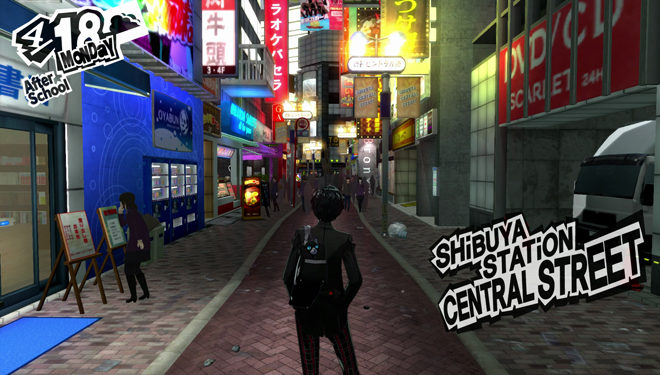
Like most previous Persona games, Persona 5 takes place in Japan and stars a silent protagonist whose name is of your choosing. Unlike them, though, its real-world aspects occur in certain districts of Tokyo, instead of a fictional city based off a real one. This increases its feeling of verisimilitude, though this goes doubly so for anyone familiar with the area. The protagonist is a 16-year-old who’s forced to move in with a new caretaker after being accused of assaulting someone and being put on probation, and enrolls in Shujin Academy in Tokyo as an unpopular student. He subsequently meets an outgoing student also bereft of many friends; but the quest seriously begins when both stumble upon the Metaverse, a portal to an alternate world that’s a reflection of reality. This leads to the birth of the Phantom Thieves, a group that changes the hearts of people who oppress those societally below them in reality. It’s a familiar tale by Persona standards following the third game, but it distinguishes itself through subsequent story and gameplay-based occurrences.
And man does it. Persona 5 tackles more realistic situations compared to its predecessors, issues citizens of Japan (and some outside it) deal with every day, albeit through the lens of teenagers. It tackles societal issues like depression, emotions that can sometimes lead to suicide, and eventually gets more political than most forms of Japanese media — even outside of video games. While it’s not as dark and oppressive in its storytelling approach and themes as Persona 3, it’s more heavy-handed than Persona 4 in utilizing the aforementioned themes. They work as justification for why this group of characters wants to make a difference in changing society for the better. It lives up to the Persona team’s promise in challenging what people expect from a Japanese RPG.
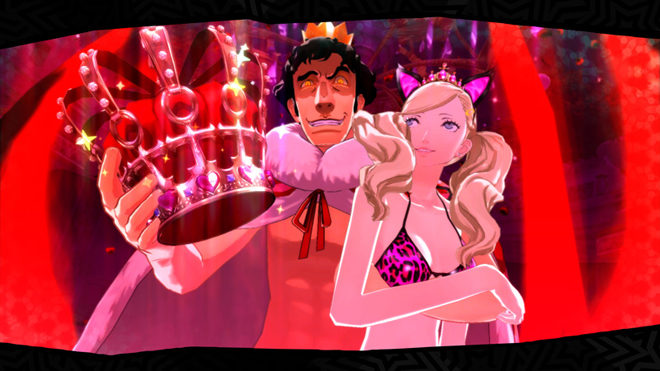
That’s not to say its story doesn’t run into some hitches, as some in-game occurrences run contradictory to the lessons and morals it wants to provide. It’s strange, for instance, to see how one character who’s nearly a victim of a sexual crime, a realistic situation, is subsequently inserted into a series of fanservice-laden situations. And that’s far from the only occurrence where these contradictories manifest. The developers faced the unfortunate dilemma between having a story they wanted to tell, and the need to appeal to the otaku audience. It doesn’t throw the story off track too badly, but hopefully they can strike a better balance between the two without fanservice subsuming everything for future installments.
Like previous games, the protagonist has to live a normal life outside dealing with realistic and otherworldly issues, and he’s guided by the player through a semi-realistic simulation of real life. He goes to school, can get a part-time job, and can raise his stats doing fun or serious activities on the side. But most of the free time will be spent with Confidants, this game’s equivalent to “Social Links.” Here, you’ll spend time conversating with party members and other important characters to learn more about them, and deepen your bond — to the point of starting a relationship with some female characters.
With Persona 5, it’s a little more obvious to know which choices should be picked for Confidants to feel worthwhile about spending time with the protagonist. While that removes some risk involved, it makes every conversation feel worthwhile for the player to ensure their strict free time feel well spent. Given how much time is dedicated to mandatory story events and venturing through dungeons, the developers wanted players’ free time to be spent wisely.
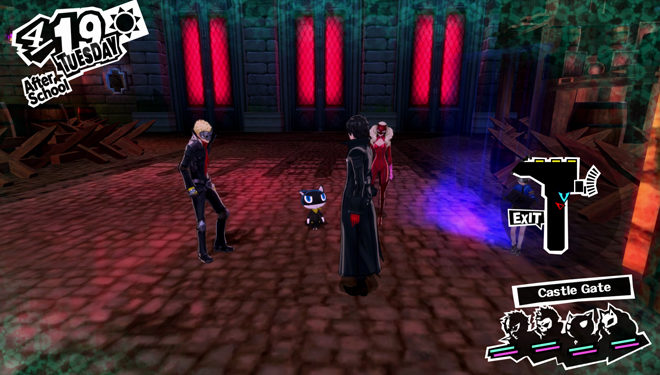
By this point, I’ve provided the impression that Persona 5 takes many features from previous games and polishes them to a sheen. While that’s accurate, nowhere is that more present than through its dungeons. On free days, players have the option of venturing to the Metaverse to go through palaces, which have to be completed by story-related deadlinex. But the biggest change is how real dungeons have been crafted for this installment instead of those with randomized floors like in previous games, and they’re far more enjoyable to explore thanks to the increased level of variety they offer. While the stealth the thieves have to abide by is nothing special, as it’s easy to sneak up on enemies and the penalty for being spotted isn’t harsh, it’s more intuitive compared to simply hitting shadows to initiate battles.
While there have been complaints about how long they are, they’re made so players can’t explore them fully in one day. The party is bound to get low on SP for magic attacks and healing after a while, and items that restore SP are rare and expensive early in the game, so it’s good to pace yourself. And for anyone that misses dungeons with randomized floors, one is still here in the form of Mementos, which hearkens back to Persona 3’s Tartarus. It’s a mostly optional affair that doesn’t take long to venture through when the game lets you enter to defeat targets and explore, though it’s drug down by the lack of variety in its locations and the monotonous music. But not enough of the game is spent in here for it to be a huge hassle.
Persona 5 continues the trend of having turn-based battles, and hitting enemies with their weaknesses will knock them down and grant a party member “One More” turn. Battles themselves are quicker and more stylish for this installment, so they’re never a hindrance.
Instead of fighting unique Shadows like in previous installments, they take the form of demons from mainline Shin Megami Tensei titles and other Megaten games, a good decision considering there’s a far larger variety of them. Negotiation to recruit a Persona into your ranks returns here, but negotiation tactics are less of a hassle than in the older games, and less random than in the Shin Megami Tensei IV titles. Characters can also use guns and melee weapons in battle, a nod to other Megaten games and the first Persona, and “Frei” skills, “Psio” skills, and Light and Dark spells that haven’t been seen since the Persona 2 duology return. Battles are affairs of both style and substance, making them the best in the franchise yet.
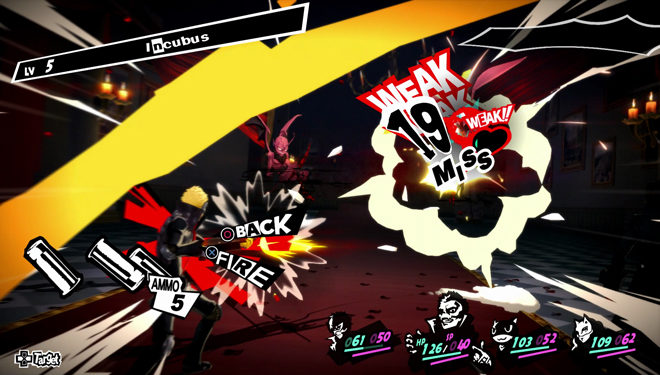
In fact, the entire presentation is a massive leap forward from previous games, and it’s evident plenty of time and money was used to make everything snazzy. Everything from the art style and character designs to even the menus and transition screens ooze style. While substance is by far the most important factor, it shows how appreciable aesthetics can be.
It’s a pity that stylishness can’t be upheld in every part of the game, as it falters in one key aspect: the localization. Atlus USA has a history of being one of the best localization companies in the business, and though Persona 5’s is far from the worst around, it’s a step down from their usual efforts. Too many lines were translated too literally while others lack flair, both in lieu of receiving the usual florid treatment. It sounds like the translation team rushed through this, and the high number of editors who worked on it (eight, while most localizations have one or two) shows how they tried to fix their issue by throwing more people at it. This is one of the biggest games in Atlus’ history, and it’s a shame it was handled like this when they’re capable of providing much better work.
Fortunately, the voice actors were able to overcome the writing issues and turned in solid performances. That’s remarkable considering the lead cast members for this installment were neophytes compared to the longtime veterans that voiced the main characters in previous games.
The soundtrack, mainly composed by Shoji Meguro with minor contributions from Atlus’ other composers, is mostly excellent. It channels the acid jazz feel Meguro claimed he wanted to provide before the game’s release for a different-though-fitting feel compared to music from previous titles. It’s unfortunate that it sometimes feels as if there aren’t enough tracks, as many of the same ones are reused in several scenes and during days where the player is free to explore Tokyo throughout the game. If (when?) they do an updated version, they should make sure to add some more variety here.
Don’t let any of those gripes deter you from playing it, as the entire package of Persona 5 is one of the best Japanese RPGs not only this year, but in this console generation thus far. I opened my review by acknowledging how hard a time the Persona team undoubtedly had in topping Persona 4, but they delivered an excellent product. Now, the burden will be even heavier on the shoulders of the Persona 6 team, particularly considering many team members responsible for this game are moving on to a new property. A younger, more inexperienced team will be working on the next game, and despite the immense pressure they’ll have, hopefully they can at least match this title in quality.

